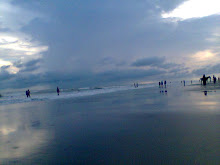
Moving by the river through the beautiful backwater of Calicut, Varthema reached the city of Kalyankullam inhabited by Nestorian Christians. From there he went to Negapatnam and to Ceylon, via Tenasserim (now Mergui), whose Hindu king was then at war with Vijayanagar and Bengal. A number of Muslim merchants were living in a separate street.
From Mergui, Varthema reached the city of Bengala, generally identified with Saptagram after eleven days journey on 13 March 1505. The sultan (obviously husain shah) kept Muslim foot soldiers. He was then at war with Vijayanagar. There were very rich merchants, who lade fifty ships annually with cotton and silk stuff. These goods, some of which were muslins, were exported to Turkey, Syria, Persia, Arabia, Ethiopia and all over India. Jewels were imported and Varthema found some of these Nestorian Christians dealing with jewels. They did not wear shoes. Varthema believed that Saptagram was the best place in the world to live in. From there he took a ship for Pegu.
Reaching Pegu on 1 April 1505, Varthema travelled through Malacca, Sumatra, Banda, Moluccas Island, Java and then came back to Calicut to describe the naval battle between Calicut and the Portuguese on 16 March 1506. He left Cochin on 6th December 1507 and returned to Rome in December 1508 via Mozambique and Lisbon.
His first book appeared in Italian at Rome in 1510 and soon ran into several reprints. The Latin edition appeared in 1511 and a German edition came up in 1515. It was first printed in Spanish in 1520, in French in 1556 and in Dutch in 1563. Richard Eden translated it into English in 1577. In 1863, John Winter Jones translated it into English from the Italian edition of 1510. Several reprints in different languages had appeared by that time. The authenticity of the account of Varthema was first doubted by Garcia de Orta in 1550, a view that was shared by Henry Yule and other scholars. However, the account of Varthema, by and large, was found to be plausible, although Varthema was prone to narrate tales of his adventure more too often.
The importance of the account of Varthema lies in his description of the customs and manners of the people, products of the countries as well as the details of the Portuguese attempts to get a foothold in India. Varthema had become a Portuguese factor in Cochin and was knighted by the Portuguese Viceroy Francisco d' Almeida. His account also leaves no doubt regarding the existence of a sizeable number of Nestorian Christians and the vigorous commercial activities of the Muslim merchants. His description of the ships and boats remains the best of the period. [Aniruddha Ray] (3rd of 3rd)
Bibliography EF Oaten, European Travellers in India, Indian ed., Lucknow, 1973, reprinted from 1909 ed; JH Jones (tr), The Itinerary of Ludvico Di Varthema of Bologna, with a discourse by RC Temple, AES, 1997 (Indian ed, reprint of 1863 ed).
From Mergui, Varthema reached the city of Bengala, generally identified with Saptagram after eleven days journey on 13 March 1505. The sultan (obviously husain shah) kept Muslim foot soldiers. He was then at war with Vijayanagar. There were very rich merchants, who lade fifty ships annually with cotton and silk stuff. These goods, some of which were muslins, were exported to Turkey, Syria, Persia, Arabia, Ethiopia and all over India. Jewels were imported and Varthema found some of these Nestorian Christians dealing with jewels. They did not wear shoes. Varthema believed that Saptagram was the best place in the world to live in. From there he took a ship for Pegu.
Reaching Pegu on 1 April 1505, Varthema travelled through Malacca, Sumatra, Banda, Moluccas Island, Java and then came back to Calicut to describe the naval battle between Calicut and the Portuguese on 16 March 1506. He left Cochin on 6th December 1507 and returned to Rome in December 1508 via Mozambique and Lisbon.
His first book appeared in Italian at Rome in 1510 and soon ran into several reprints. The Latin edition appeared in 1511 and a German edition came up in 1515. It was first printed in Spanish in 1520, in French in 1556 and in Dutch in 1563. Richard Eden translated it into English in 1577. In 1863, John Winter Jones translated it into English from the Italian edition of 1510. Several reprints in different languages had appeared by that time. The authenticity of the account of Varthema was first doubted by Garcia de Orta in 1550, a view that was shared by Henry Yule and other scholars. However, the account of Varthema, by and large, was found to be plausible, although Varthema was prone to narrate tales of his adventure more too often.
The importance of the account of Varthema lies in his description of the customs and manners of the people, products of the countries as well as the details of the Portuguese attempts to get a foothold in India. Varthema had become a Portuguese factor in Cochin and was knighted by the Portuguese Viceroy Francisco d' Almeida. His account also leaves no doubt regarding the existence of a sizeable number of Nestorian Christians and the vigorous commercial activities of the Muslim merchants. His description of the ships and boats remains the best of the period. [Aniruddha Ray] (3rd of 3rd)
Bibliography EF Oaten, European Travellers in India, Indian ed., Lucknow, 1973, reprinted from 1909 ed; JH Jones (tr), The Itinerary of Ludvico Di Varthema of Bologna, with a discourse by RC Temple, AES, 1997 (Indian ed, reprint of 1863 ed).

No comments:
Post a Comment